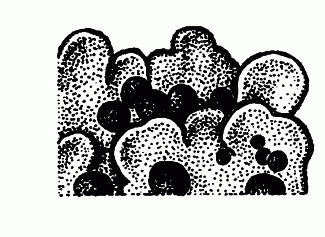Click on the image below to view an
expanded illustration for this species.

|
General:
Common Name: The Scale Lichens. Suggested by the tiny, rounded, often somewhat overlapping lobes of the species.
Small stratified squamulose lichens, corticate above, corticate or not below, nonsorediate, nonisidiate, squamules broadly attached to substrate or more often attached at one margin, closely appressed to loosely attached, short to more often subrotund, averaging to 2–5 (–8) mm wide, usually rather thick. Upper surface pinkish or more often brownish, somewhat shiny or not, often white-pruinose. Lower surface pale or darkening, lacking rhizines. Medulla white. Photobiont green.
Apothecia located over upper surface or along squamule margins, disc usually convex or hemispherical when mature, reddish brown to black; spores simple, ellipsoid, colourless, 8 per ascus.
Over exposed, base-rich soil or rock.
Notes: Psora is primarily a genus of semi-arid or arid areas, especially at temperate latitudes. Of the 17 species reported for North America, seven are found in B.C. This is a taxonomically difficult genus in which the species are not always clearly circumscribed.
Species description:
Over soil, moss or occasionally base-rich rock; lower surface pale, sometimes cottony; fruiting bodies (apothecia) not immersed, usually hemispherical at maturityAND
Apothecia reddish brown, brown or black, situated primarily over upper surface of lobes (check young apothecia); lobes appressed or ascending; upper surface never bright red AND
Lobes appressed or at most weakly raised, not distinctly ascending; upper surface brownish; apothecia simple, black to reddish brown AND
Apothecia dark brown to black; upper surface generally dark brownish AND
Lobes not or only faintly white-pruinose along margins (but occasionally pruinose on upper surface, especially near margins); lower surface brownish AND
Apothecia strongly convex (often hemispherical) at maturity; lobes averaging to more than 1 mm wide; upper surface at most weakly pruinose, often distinctly fissured; medulla KC-, lacking gyrophoric acid; distribution various AND
Upper surface with shiny “waxen” appearance, especially near margins, usually dark reddish brown
Comments:
Most, if not all, of the B.C. material previously identified as P. luridella can be referred to P. globifera. A few recent specimens were tentatively assigned to P. luridella by E. Timdal who observes, however, that the distinction between these two species is not always clear. The lobes in P. globifera should be thicker, more fissured and less closely appressed than those in P. luridella. These characters, however, are doubtless subject to considerable environmental modification, leaving open the question whether P. luridella really does occur in B.C.
Reactions:
All spot tests negative.
Contents:
No lichen substances reported.
Source: Lichens of British Columbia |
